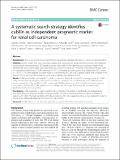A systematic search strategy identifies cubilin as independent prognostic marker for renal cell carcinoma
Abstract
Background There is an unmet clinical need for better prognostic and diagnostic tools for renal cell carcinoma (RCC). Methods Human Protein Atlas data resources, including the transcriptomes and proteomes of normal and malignant human tissues, were searched for RCC-specific proteins and cubilin (CUBN) identified as a candidate. Patient tissue representing various cancer types was constructed into a tissue microarray (n = 940) and immunohistochemistry used to investigate the specificity of CUBN expression in RCC as compared to other cancers. Two independent RCC cohorts (n = 181; n = 114) were analyzed to further establish the sensitivity of CUBN as RCC-specific marker and to explore if the fraction of RCCs lacking CUBN expression could predict differences in patient survival. Results CUBN was identified as highly RCC-specific protein with 58% of all primary RCCs staining positive for CUBN using immunohistochemistry. In venous tumor thrombi and metastatic lesions, the frequency of CUBN expression was increasingly lost. Clear cell RCC (ccRCC) patients with CUBN positive tumors had a significantly better prognosis compared to patients with CUBN negative tumors, independent of T-stage, Fuhrman grade and nodal status (HR 0.382, CI 0.203–0.719, P = 0.003). Conclusions CUBN expression is highly specific to RCC and loss of the protein is significantly and independently associated with poor prognosis. CUBN expression in ccRCC provides a promising positive prognostic indicator for patients with ccRCC. The high specificity of CUBN expression in RCC also suggests a role as a new diagnostic marker in clinical cancer differential diagnostics to confirm or rule out RCC.
Citation
Gremel , G , Djureinovic , D , Niinivirta , M , Laird , A , Ljungqvist , O , Johannesson , H , Bergman , J , Edqvist , P-H , Navani , S , Khan , N , Patil , T , Sivertsson , Å , Uhlén , M , Harrison , D J , Ullenhag , G J , Stewart , G D & Pontén , F 2017 , ' A systematic search strategy identifies cubilin as independent prognostic marker for renal cell carcinoma ' , BMC Cancer , vol. 17 , 9 . https://doi.org/10.1186/s12885-016-3030-6
Publication
BMC Cancer
Status
Peer reviewed
ISSN
1471-2407Type
Journal article
Description
This work was supported by the Swedish Cancer Society and the Knut and Alice Wallenberg Foundation. The work of DJH and GDS was funded by the Chief Scientist Office (grant number ETM37), Renal Cancer Research Fund and Kidney Cancer Scotland.Collections
Items in the St Andrews Research Repository are protected by copyright, with all rights reserved, unless otherwise indicated.

